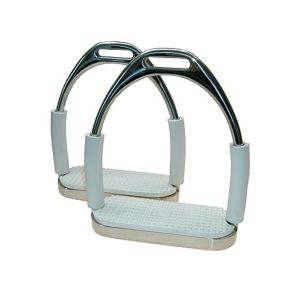Have you ever arrived at a horse show with tack that you thought you had cleaned thoroughly the night before, only to find that it looks dull or, worse, has noticeable grime on it? This is an easy situation to get into if you don't clean your tack daily or if you just quickly wipe down your tack without really giving attention to the areas where dirt builds up the most easily. Clean tack is not only a sign of respect for the judge, but it also contributes to that first impression that tells the judge whether or not you are there to win.
Wetting the layer of grime while washing tack can actually make the dirty layer temporarily appear dark and transparent, which is why you often notice the next day, when the tack is dry, that it isn't as clean as you thought it was. Tack that is truly clean has a very recognizable lustre and richness that is well worth the extra effort.
To avoid the surprise of tack that isn't as clean as you thought it was, there are certain areas of the bridle that can serve as warning signs that your tack needs a very thorough cleaning. Because it's difficult to spot the grime once it has gotten wet, I recommend scheduling the intensive cleaning session for at least two days before you show, giving you an opportunity to spot and re-clean any missed areas the next day.
Here are the areas of the bridle to which you should pay extra attention. Other spots will still need attention, but I have found that these are the most easily missed:
Inside the browband and noseband:
These areas will not be visible while you're showing, but I imagine that horses must appreciate not having sticky, rough surfaces in contact with their faces. Less-than-thorough cleaning here will also often indicate a lack of cleaning elsewhere.
How to clean it: While some prefer to use a toothbrush to get into the small spaces, I actually prefer to scrape out the stitched areas with a fingernail, being careful not to scratch the leather. After a wipe with your soapy sponge, the grime should become soft enough to scrape off, and following up with a clean wet sponge should take care of any remaining residue.

The buckles:
Look closely at the buckles, particularly where the tongue of the buckle rests. Dirt builds up easily on buckles and dulls them.
How to clean it: Use a wet, soapless sponge to wipe off any dirt. If there is a lot built up, gentle use of your fingernails can again be very effective. Be sure to lift up the various parts in order to clean the buckles thoroughly without leaving grimy edges.
The insides of your reins:
This is one of the worst locations for grime build-up, thanks to the movement of the reins against the often-sweaty neck. Not only does this indicate that your tack needs cleaning more often, but the grime is also visible from the other side under your horse's neck!
How to clean it: Once again, I find my fingernails to be most effective here. Wipe the area down with water and saddle soap to soften the dirt, and then run your fingernail gently down the length of the dirty area, making enough passes to cover the width of the rein. Wipe off any remaining residue with the sponge and then repeat as necessary. Don't forget to pay close attention to the raised strip where the grippy part of the reins begins.
Where the reins attach to the bit:
This area tends to attract a lot of saliva from the mouth, making it both a magnet for little bits of hay and prone to dryness. Keeping it clean (and conditioned) will help the leather last a long time without failing on you mid-ride.
How to clean it: Try to squish your sponge enough that it will fit in there and then expand to pull everything out with it. If that doesn't work, the trusty fingernail/toothbrush or unfastening it to open it all up will do the trick.
The throatlatch:
This is one of the least obvious areas to look at, but it is often dirty! There is an area on each side of the throatlatch, just above the bottom of the horse's chin, where dirt can build up thanks to the motion of the loose leather and any flexing of the head and neck. It usually creates a line that will be slightly dull or appear a slightly different colour than the rest of the throatlatch.
How to clean it: If sponging alone won't do it, gently run your fingernail down the dirty area and then sponge it off. I find that this area is one of the worst for appearing clean when wet and then reverting back to being dull when dry, so pay extra attention to it the day after the thorough tack cleaning.
Some other areas to pay attention to are any with deep stitching (surrounding any raised areas), as well as holes on straps which can become clogged with dirt (the tongue of the throat latch buckle is very handy for cleaning out clogged holes). These areas are, however, easy to clean in a single session and don't tend to suffer from the same level of grime build-up as do the above-mentioned trouble spots. If you are able to keep these five special areas clean, it's likely that the rest of your bridle will end up spotless as well.



























